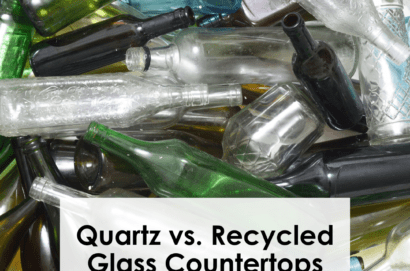Growing up in Vermont, there was an artisanal aspect to granite. Fine Italian craftsmen and sculptors created beautiful works from the black speckled gray granite that was a beautiful, vital part of the Vermont landscape. The headstones in the graveyards are beautiful to see, and walking through a graveyard is not an eerie experience, but rather like walking through a historical monument.
But this is not the granite graveyard that is the blight on the stone fabrication industry today. The granite graveyards today are wasteful scraps of giant slabs of granite that are off-cuts from manufacturing countertops for residential and commercial clients. Every job gets templated and sinks are cut out, the slab is cut down to the appropriate size, and possibly up to 30-40% of the slab can be waste. This waste is set aside and leaned up on A-frames, piece by piece laid in front of one another, until eventually thousands of square feet of different sizes of granite and quartz litter the backyards of stone fabricators everywhere. When considered in aggregate, this is hundreds of millions of square feet of stone materials that will never get used. Many fabricators do not catalogue or inventory these partial slabs, depending on their size, so really have no way to sell them, even if they wanted to try.
The industry has not come up with a good solution to this problem, but they need to be challenged to do so. There needs to be a channel for this material to get to market so as not to go to waste. One current options is using it for roadbeds and as a ground filler before paving, but it is a small portion of the scrap out there, and not a realistic option for many stone fabrication companies, as it may not be a readily accessible outlet. These small pieces of stone are suitable for ledges, table tops, vanities and cutting boards. They could be donated to Habitat for Humanity, used for affordable housing or other donation based organizations. In the past, some companies have developed technology for crushing the stone and stamping it into pavers.
Image from: http://petromramor.ru/index.php?lan=eng&nav=6322
The argument can be made that granite comes from the earth, so putting it back there should be a good solution. This argument cannot be made for quartz, which contains resins that are not suitable to be thrown back into the ground, as they are man-made, and petroleum based. The reality is that we want what we want and don’t consider the waste that it creates in the process. You pick a 5 foot by 7 foot slab of granite and use two 2 foot wide pieces that are 6 feet long. So you used 2/3 of the material, and 1/3 could go to waste. Nobody tells you that, but it is a reality. Multiply that times millions of households and it really adds up.
The challenge the stone industry needs to embrace as a whole is finding an outlet for this material or innovating with a thought leader in the industry to find a solution.
While these granite graveyards grow and grow, the granite graveyards of my childhood are frozen in time, never growing, beautifully memorializing the days when granite required an artisan’s touch.























